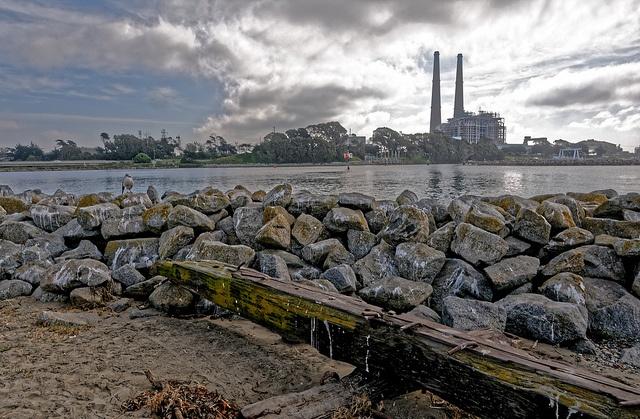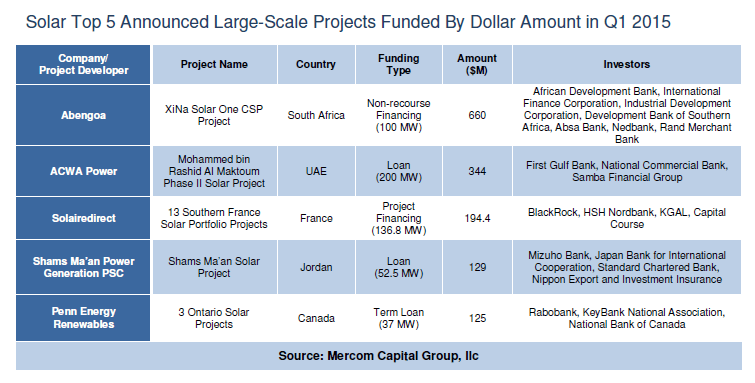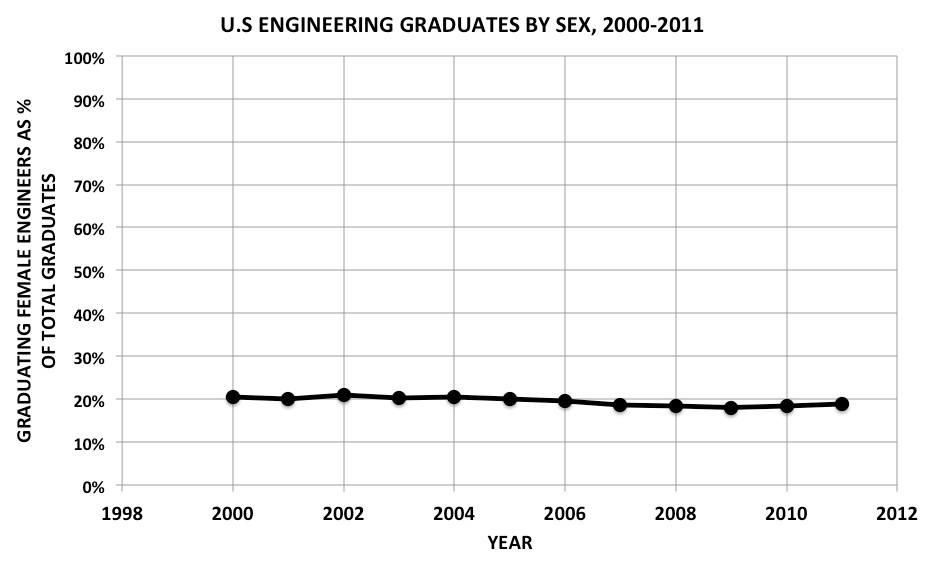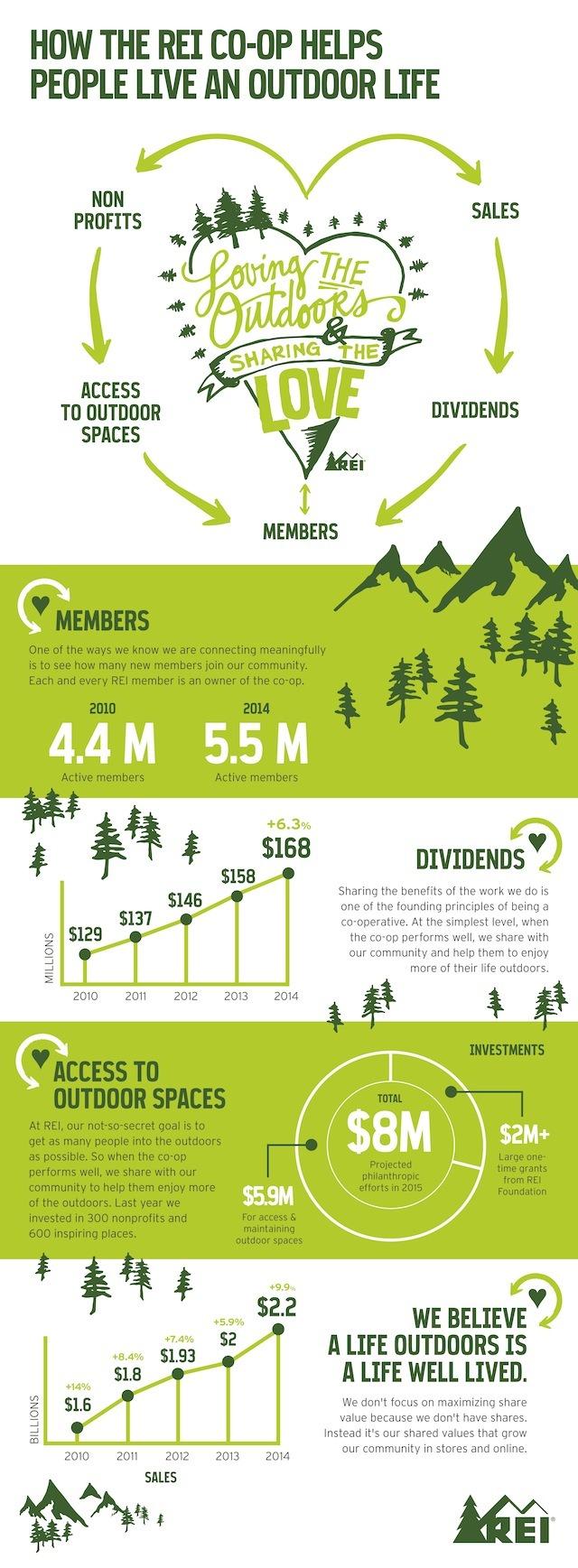California’s Hidden Water Consumer: Power Plants


As California suffers through its fourth year of record drought and Gov. Jerry Brown imposes mandatory water restrictions for the first time in the Golden State’s history, the debate rages on over who consumes the most water and who should be responsible for cutting back. Is it homeowners and golf courses with a penchant for full green lawns, almond growers who need a gallon of water to produce one single almond, or the beef industry that uses 2,500 gallons of water for every pound of hamburger patty?
But there’s another major consumer of water in California and the United States – one that doesn’t receive the same attention as lush lawns or the agricultural industry: power plants. In 2005, power plants across the country withdrew as much water as farms did, according to a 2011 report, Freshwater Use by U.S. Power Plants: Electricity’s Thirst for a Precious Resource, from the Union of Concerned Scientists and a team of independent water experts. The report also found that power plants withdrew four times as much water as all Americans did -- meaning that, on average, lighting rooms, powering home electronics and running appliances require more water than washing dishes and clothes, showering, flushing toilets, and watering gardens.
Why do power plants use so much water? Most power plants in the U.S. are thermoelectric, the report said, meaning they boil water to produce steam that, in turn, spins turbines that generate electricity. Large quantities of water are also used to cool this steam.
In California and other coastal states, power plants rely more on seawater than fresh water to operate, the study noted. Indeed, in 2005, power plants in the Golden State withdrew 12.6 billion gallons per day of saline water and 50 million gallons per day of fresh water, according to the state’s Department of Water Resources. Overall, water withdrawals by thermoelectric power plants accounted for 28 percent of the state’s water withdrawals in 2005, the agency reported. It is important to note that “water withdrawal” is the total amount of water a power plant takes in from a source like a river, lake or aquifer – some of which may be returned.
So, should Californians be concerned about power plants’ water use when the majority comes from the ocean and, according to the Union of Concerned Scientists’ report, most thermoelectric power plants in the state are highly efficient? Though the 12.6 million gallons of water per day that Californian power plants extract from the sea may not directly compete with the drinking water supply yet (although proposals for desalination plants are rearing their ugly heads again), seawater withdrawal does have environmental consequences, the report said. Water intake systems on power plants can trap fish and other aquatic animals, while the water used for cooling and then returned to the ocean at a warmer temperature can also harm marine life.
And Californian power plants’ need for 50 million gallons of fresh water each day is not an insignificant amount either – not when public officials, industry and residents are bickering over every last drop of water and when there are readily-available solutions to the problem of energy-related water use. These solutions include energy efficiency, dry or low-water cooling technologies for power plants, and certain forms of renewable energy like wind turbines and solar photovoltaics. Some concentrating solar power plants consume more water per unit of electricity than the average coal plant, the report found, but these facilities can also employ dry-cooling techniques to cut down on water use.
Indeed, the California Solar Initiative, which provided solar rebates to homes and businesses, has installed enough solar power systems to conserve 684 million gallons of water a year, said Will Craven, director of public affairs for SolarCity.
“The average American consumes more water via consumption of electricity than they do via direct water consumption. Utilities are the second largest water consumer in the nation,” Craven said. “Meanwhile, solar’s greatest near-term benefit may be its water efficiency. Between steam systems for coal plants, cooling for nuclear plants and fracking for natural gas wells, energy production consumed 66 billion cubic meters of the world’s fresh water in 2010. By contrast, solar consumes practically no water at any stage of its development or deployment.”
So, as California cities consider outdoor watering restrictions and farmers in the Golden State think about which crops to grow given their water allocations, we should remember the other tools we have ready to help us save water and survive the drought -- energy efficiency, solar photovoltaics and wind farms -- some of the same solutions that will help us fight climate change.
Image credit: Flickr/Don DeBold
Chipotle’s Shortage of Naturally-Raised Pork Highlights Problems


Try to find organic bacon or any organic pork product at your local grocery store. Good luck. Organic pork just doesn’t exist in the U.S. It’s hard enough to find antibiotic-free pork.
Chipotle Mexican Grill knows all about this difficulty. Back in January, the fast-casual restaurant chain stopped serving pork at hundreds of its restaurants. Now it is mid-April, and the company is still not serving pork at some of its restaurants. It has also run out of chicken and beef at some locations, Bloomberg reports.
When it comes to sourcing ingredients, Chipotle sets the standards high. Those standards are part of its Food With Integrity program. As part of the program, the company buys only pork from pigs that are “raised outside or in deeply bedded pens,” as its website states. Chipotle also sources its pork from pigs fed a vegetarian diet and not given antibiotics. Since 2001, the company has only sourced its pork from suppliers that follow those guidelines.
When it comes to beef, Chipotle has sourced “naturally raised” beef since 1999. That means buying beef from producers that do not give cows hormones or antibiotics. The chicken the company buys comes from 100 percent antibiotic-free sources.
Chipotle acknowledges on its website that it will “occasionally” experience shortages of chicken and meat. The reason for shortages is because there just aren’t enough naturally-raised chickens, cows and pigs. Antibiotic-free meat probably accounts for less than 5 percent of total meat sales, according to a Natural Resources Defense Council (NRDC) report published last October. By some estimates, reporting in 2012 showed sales of antibiotic-free meat were up by 25 percent over the three previous years. While sales of antibiotic-free meat are increasing, consumption of meat in the U.S. is decreasing. Per capita consumption of meat in four major categories (beef, pork, chicken and turkey) decreased during the same time period.
Consumers want antibiotic-free meat, as several surveys show. A 2012 Consumer Reports survey found that 61 percent of those polled said they would pay 5 cents extra or more per pound for antibiotic-free meat, and 37 percent said they would pay a dollar more per pound. An Ipsos/Reuters poll conducted in March found that 61 percent agreed that eating antibiotic-free meat is important to them.
Consumers are not the only ones concerned about antibiotics routinely given to livestock and poultry. A 2014 Consumer Reports survey found that 93 percent of doctors polled are concerned about the routine use of antibiotics, and 97 percent are concerned about drug-resistant infections.
It is a wonder that there is such a short supply of antibiotic-free meat given the consumer interest in antibiotic-free meat, the concern of doctors and companies like Chipotle adopting stricter sourcing standards. Perhaps as more consumers become aware of the increasing amounts of drug-resistant infections, they will start seeking out antibiotic-free meat. Surely, supply will eventually have to meet demand.
Image credits: 1) Yelp user Joyce K. 2) Deraman Uskratzt
Culture vs. the Ethical Bank


By Vince Siciliano
UBS. JPMorgan Chase. Wells Fargo. Barclays. And now, HSBC. Since the U.S. mortgage meltdown, “big banks," titans of global business, have continually been caught in ethical failings. Tax avoidance, interest rate manipulation, commodity and currency speculation, and money laundering, among other charges, have all surfaced -- calling into question banks’ ability to act in society’s best interests, not just their own or their clients’. Are we to assume that all banks are bereft in acting morally?
Pundits speculate whether banking culture is to blame – big banks today seem defined by their speculative ventures, self-congratulatory cleverness, loophole exploitation and profit maximization. With big bailouts as rewards for ethical missteps, it is a win-some-lose-none environment that has emboldened bankers to take increasing risks with little punishment or accountability. It is a system of inherent incentives that encourages maximum profit without engagement or responsibility in an exterior world.
Would a culture shift turn banking around? If bankers were given better hours, down-time, happy hours, counseling – would they make more ethical decisions?
While happier employees may improve office culture, there will be no impact on the underlying values of the organization. Without a stronger code of values, these efforts are no more than Band-Aids on bullet holes. They collectively fail to address the rotten core of where the greater banking industry has gone. So long as banks are solely focused on short-term interests and are rooted in maximizing profit, there is no intrinsic motivation for change.
How then are we to create a better model for companies, organizations and individuals, so they may opt out of a banking system that inherently puts short-term profits ahead of right action? How can they begin to prioritize long-term interests for both shareholders and the common good?
There is a lesser-known model of banking that is based around a different premise. It takes a long-tail view of banking and finance, and includes all stakeholders. This we call values-based banking.
Values-based banks still prioritize capital and seek to maximize returns: The catch is that, to these banks, there are three kinds of capital under management: financial capital, social capital and environmental capital. Their commitment is not just to their shareholders, but to all their stakeholders.
This can become a powerful regulator for ethical action.
As long as there are single-bottom-line banks, singularly focused on short-term profits, shareholder capital and maximizing financial returns, there is no incentive to change culture.
Unlike single bottom-line banking, triple-bottom-line banks align their money with their values. They use their capital to help finance “real economy” businesses selling products and services, not speculative ventures. They adopt transparency principles to give public insight to how their money is being used. They consider the long-term impact of their lending decisions, in projects that support quality of life for all. They create community by forming authentic client relationships with like-minded businesses.
These banks are growing in number, as clients find them to be better, more trusted and morally-aligned partners. Perhaps the largest network of such banks, the Global Alliance for Banking on Values, is an international network of 25 independent banks with assets of nearly $100 billion that is collectively using finance to deliver sustainable prosperity for people, communities and the environment.
GABV banks are able to drive culture from the inside and find financial success as well as a clarified company vision that resonates and builds trust with partners and customers precisely because of their values.
As a society, we pride ourselves on a higher moral compass, motivated by things other than money. We are multi-sided, measuring our wealth in altruistic terms like ethics, family, nature and spirit. But when it comes to money and banking, why do big banks tend to leave these values at the door? Because we have never insisted otherwise.
Banks that have long embraced a profit-over-people mentality should take a lesson from those independents operating from a strong foundation of values. They may realize if their business model reflects a higher standard of values, their culture will follow, and they will better serve their customers, the public and the planet with a higher good.
In the meantime, banking customers around the world should take a better look at where their money spends the night. They should hold banks to a higher standard and demand better, or take their banking elsewhere.
Image credit: Flickr/401(k) 2012
Vince Siciliano is president and CEO of New Resource Bank. He leads New Resource Bank in serving values-driven companies and organizations working to achieve well being for our community and the planet. The bank seeks to transform the banking industry into an agent of positive social, environmental and financial change. Headquartered in San Francisco, the bank is dedicated to advancing sustainability through every aspect of its operations from the loans it makes to its commitment to using deposits for good. As a founding member of the Global Alliance for Banking on Values, New Resource Bank champions a community of values to transform banking and create a better world.
Siciliano currently serves on the advisory boards of the American Sustainable Business Council, the Ken Blanchard Center for Faith Walk Leadership, the Sustainable Accounting Standards Board, and the Regeneration Project. He began his banking career in Bank of America’s International Division and has previously served as president or CEO to a number of San Diego financial institutions. Siciliano is a graduate of Stanford University, and he earned a master’s degree in environmental planning from the University of California at Berkeley.Energy Storage Emerges as Key to Solar Growth


Intelligent energy storage is viewed as the "missing link" capable of promoting even faster growth in clean energy generation and distribution capacity. It's also viewed as a key enabler for building smarter, cleaner, more efficient and more resilient electricity grids.
Every year, Bloomberg New Energy Finance (BNEF) selects 10 “game-changing innovators who are revolutionizing the energy sector.” Two homegrown intelligent energy storage startups were among the winners of BNEF'S 2015 New Energy Pioneers Awards.
Greensmith and Stem are both leaders in the development of systems platforms that are capable of aggregating and integrating diverse, distributed clean energy and energy storage assets. Their solutions deliver more efficient, resilient, secure and affordable electrical power for electric utilities and their customers.
Exponential growth
The market for advanced energy storage systems is forecast to grow exponentially in 2015 and over the course of the next decade. Besides shaking up the utility and fossil fuel industries, technological advances and declining costs of advanced energy storage are prompting a growing host of investment groups, utilities included, to take equity stakes in companies that develop promising energy storage solutions.
“The storage industry is poised for an exponential increase in sales,” Eric Borden, a Berlin-based energy consultant, told Renewable Energy World in February. “Storage is today where [solar photovoltaics] was six or seven years ago ... Battery costs have declined 80 percent over the past decade."
Some 362.8 megawatts of energy storage projects were announced worldwide in 2013 and 2014, distributed nearly equally between North America, Asia-Pacific and Western Europe, according to Navigant Research. The market research company expects global installed energy storage for the grid and ancillary services to increase from 538 megawatts in 2014 to 21 gigawatts in 2024. Worldwide market revenues over this period will grow from $675 million in 2014 to $15.6 billion.
According to GTM Research and Energy Storage Assocation's (ESA) inaugural U.S. Energy Storage Monitor, Greensmith on its own accounted for a third of grid-scale energy storage software and solutions installed in the U.S. in 2014.
On March 31, Greensmith announced the latest enhancement to its GEMS4 grid-scale energy storage and integration platform. According to Greensmith, “The new StorageModel and StorageView applications offer advanced simulation and visualization capabilities to energy storage developers and owners.”
Using the two new GEMS4 applications, end users will be able “to test alternative designs and gain valuable real-time intelligence on performance, helping them optimize system design and maximize return on investment (ROI),” the company elaborates.
Initiating California's drive to install 1.325 gigawatts of power storage capacity across the grids operated by its investor-owned utilities, Southern California Edison (SCE) this past November awarded Stem a set of local energy procurement contracts. The contracts call on Stem to deploy 85 megawatts of distributed energy storage capacity “behind the meter” at customer sites across its West Los Angeles Basin service territory.
On April 13, Stem and Japan's Mitsui & Co. announced the successful closing of a first, $12 million tranche of a Series C venture capital funding round. The new capital will be used to fund Stem's geographic expansion.
When it comes to advanced energy storage technology and systems, Japan is among the nations at the leading edge of innovation and change. Ever protective of its domestic companies and industries, foreign companies continue to find it necessary to partner with Japanese companies to gain a foothold in the marketplace.
According to the joint press release, “Mitsui and Stem plan to collaborate on Stem's entry into new markets by leveraging Mitsui's customer base and sales and marketing resources. Through this investment, Mitsui will contribute to the sustainable growth of Stem's business as well as gain hands-on experience in the intelligent energy storage space.
“Mitsui has a rich history of strategic investments in businesses shaping our energy future,” Hirohiko Miyata, general manager of Mitsui's Power Projects Development Division, was quoted as saying. “The opportunity for distributed storage solutions like Stem is rapidly expanding across international markets, including our native Japan. We see much promise in the company’s unique approach to strengthen the changing grid landscape.”
Added Stem CEO John Carrington: “The value of customer-sited storage in grid-constrained regions is not exclusive to the U.S., as demonstrated by the increasing interest we’re seeing from some of the world’s largest energy players. We look forward to working with Mitsui to enable the full spectrum of customer and grid benefits available from intelligent energy storage.”
Image credits: 1), 2) Bloomberg New Energy Finance; 3) Stem
Fracking Pragmatism: Voluntary Standards for Shale Development


By Josh Garrett
Fracking is back in the news. The debate over the costs and benefits of the U.S. shale boom is heating up, despite a major slowdown in drilling activity brought on by low oil and natural gas prices.
Since modern fracking began, plenty of new information about the effects of shale development has come to light, but the defined positions in the debate remain the same: “Fracking is safe and an economic blessing” vs. “fracking is a certain environmental and public health disaster.”
There is truth to both positions: While high-volume horizontal hydraulic fracturing and the U.S. shale boom have delivered notable benefits, they unquestionably pose serious public health, social and environmental risks. But boiling down everything about shale development into “yes” or “no” positions is an oversimplified approach to a complex issue. According to a recent Gallup poll Americans are evenly divided into these two camps: 40 percent approve and 40 percent disapprove of the use of fracking to increase oil and gas production.
Meanwhile, 15 million Americans live within a mile of an oil or gas well. That number will only grow as more shale oil and gas wells appear in backyards, in parks and near schools. Faced with this reality, the most urgent question to ask about fracking and shale development is not about yes or no, but rather: How can we make it less risky for people and the environment?
Incomplete, inconsistent regulation
We're a decade into the shale boom, and clear, consistent, effective regulation of its industrial activity across states and regions remains elusive. Shale development is regulated to varying degrees at the state level. Some state regulations are effective and worthy of emulation, but none applies to the full spectrum of environmental and social impacts that shale development has on nearby communities.
Because hydraulic fracturing is exempt from several federal laws, the rule recently issued by the U.S. Department of Interior is the first national-level fracking regulation. It applies exclusively to oil and gas operations on federal and Indian lands, however, which only account for about 10 percent of nationwide oil and gas development activity.
While there are specific examples of sensible and effective regulation of fracking and shale development activities in the DOI rule and state schemes, the big picture of oversight in the U.S. is riddled with holes and inconsistencies that leave the risks to water quality, air quality, public health and quality-of-life inadequately addressed.
Voluntary performance standards: A reasonable alternative
Voluntary performance standards represent a currently nonexistent middle ground in the fracking debate: a nuanced position that supports minimizing risks and maximizing benefits rather than unqualified support or opposition. Industry can demonstrate its commitment to safety and reducing environmental impacts by adopting rigorous, comprehensive, transparent and independently-verified standards for social and environmental responsibility. Communities affected by development operations can use the framework of performance standards as a tool to engage with companies and set reasonable expectations for transparency and impact mitigation. Social and environmental standards worked to make the timber and commercial fishing industries more transparent, accountable and responsible. Why couldn’t they work for fracking?
Equitable Origin is taking on that question with the draft EO100 for Shale Oil and Gas standards for social and environmental performance. The draft standards provide guidance on social (in contrast to the DOI rule) and environmental performance to address the various impacts of shale development — from truck traffic to air quality — and reduce the risks of problems like water contamination from faulty well casings. Requirements for consultation between the operators of shale sites and local communities are a central component of the standards.
Benefits for companies and communities
If shale developers and communities approach development projects from a realistic and cooperative perspective while using performance standards as a framework for productive engagement, both parties stand to benefit. Communities can become more informed about what to expect from development projects and can secure public commitments from companies to adopt the best social and environmental practices, verified by objective third parties. Companies can establish more positive and productive relationships with affected communities that reduce the likelihood of costly legal action or protest that could slow or shut down their operations.
In the fracking debate, the loudest voices call for fracking bans or unrestricted shale development across the U.S. and the world while the voices of people directly affected by shale development go unheard and government regulations fall short of protecting their interests. Voluntary standards could help lay the foundation for a new perspective on fracking: not all good, not all bad, but complex and in need of close examination, careful planning, and the application of practices that consider the interests of all stakeholders.
Image credits: derrickhand300, investorvillage.com; foodandwaterwatch.org
Josh Garrett is the Director of Communications at Equitable Origin, where he leads the organization's shale standards and certification projects. He is dedicated to forwarding social and environmental causes by conveying the multiple benefits of social equity and sustainability to businesses, consumers, policymakers, and NGOs alike. He holds a Master of Public Administration degree in environmental science and policy from Columbia University.
Residential and Commercial Solar Funds Raise Nearly $2 Billion in Q1


Corporate funding in the solar energy sector recovered strongly in the first quarter of 2015, surging 88 percent above the $3.4 billion posted in Q4 2014 to total $6.4 billion worldwide, according to Mercom Capital's Q1 2015 Solar Funding and Merger and Acquisition report.
Mercom's quarterly market research reports encompass corporate funding of solar energy from venture capital (VC), public markets and debt financings globally. Its latest quarterly report highlights the “maturing” of solar energy finance as the solar energy sector continues to gain confidence, credibility and legitimacy among banks, fund managers and other investors.
VC solar-sector funding dropped from $315 million across 16 transactions in Q4 2014 to $189 million in 26 transactions in Q1 2015. But residential and commercial solar energy funds turned in their best performance to date, raising nearly $2 billion in 10 deals. That's nearly double that for Q4 2014, in which they raised $1 billion across eight deals, Mercom highlighted.
Strong quarterly rebound in solar-sector finance
Solar-sector debt financing also rose sharply quarter-over-quarter, shooting up 233 percent in Q1 2015. As compared to the debt financing total of $1.5 billion posted in Q1 2014, the first quarter of this year saw about $5 billion raised via debt issuance in 27 transactions.
In addition to the sharp rise in global solar-sector debt finance, solar energy companies raised $1.26 billion across 10 public market financings in the first quarter of 2015, according to Mercom's latest quarterly report. SolarEdge's NASDAQ IPO, in which it raised $126 million of equity capital, was the sole IPO during the quarter. Fremont, Calif.-based SolarEdge “is a balance-of-systems company that provides inverter, optimizer and monitoring solutions,” Mercom elaborated.
Circling back around to VC funding, Conergy raised $45 million from VC investment groups -- the largest solar-sector funding of its kind in Q1 2015. Filling out the top VC solar-sector funding deals of the quarter were NEXTracker raising $25 million; Fenix International raising $12.6 million; $12.5 million in VC funding raised by M-KOPA Solar; and Oxford Photovoltaics raising $12.3 million.
Along with solar-sector VC funding, large-scale project funding dropped to about $2.5 billion across 29 transactions last quarter. That compares to $3.4 billion in 33 deals Mercom registered for Q4 2014.
In terms of power capacity, new large-scale project finance announcements in Q1 totaled 7 gigawatts across 190 projects. Investors, and consumers, are getting a lot more “bang for the buck” as the cost of deploying solar energy systems continues to decline.
Other key takeaways from Mercom's Q1 2015 Solar Funding and M&A report include:
- Solar mergers and acquisitions activity in Q1 2015 came to $563 million in 29 transactions (eight disclosed), compared to Q4 2014 with $2.2 billion in 21 transactions (eight disclosed);
- Project acquisition activity remained robust this quarter with 44 transactions (20 disclosed) for a total of $953 million;
- About 2 gigawatts of solar projects was acquired in Q1.
Moving Natural Assets from the Drawing Board to the Board Room


Roy Brooke
Society understands the value provided by green space, streams, forests and lakes. Far too often, however, these ‘valuations’ can’t be converted into something that business owners, city planners and politicians can easily use for decision-making. As a result, the valuation of natural capital, despite its massive potential to stop or reverse the decline of our dwindling ecosystems, remains an academic or communications exercise.
At first glance, the town of Gibsons on Canada’s West Coast seems an unlikely challenger to this state of affairs. But in this outwardly sleepy town, a change is brewing that is moving the community from ‘valuing’ natural capital to actually doing something about it. The implications are huge.
In fact, Gibsons is now ahead of any other town or city on the continent in its efforts to weave natural capital into the DNA of urban decision-making.
Gibsons is doing three things:
- First, the town is translating the value of its natural assets (forests, streams, shoreline, etc.) into tangible ‘municipal service’ terms such as rainwater management, flood control and water purification.
- Second, town government is calculating the risks and costs if these features get degraded. For example, the town realized one of its parks was not just a nice spot for joggers, but also the chief reason that it required less expensive storm-water systems. If the park were to get degraded, the town would be on the hook for huge new sewer expenses.
- Third, and most important, the town has adopted North America’s first asset management policy. This policy recognizes natural assets as an asset class, and enables the town to use traditional infrastructure and financial management systems to manage their natural assets.
Practically speaking, natural assets that were once invisible in the town’s ledgers are now front and center, with operations, maintenance and financial plans to ensure their integrity. And because forests and beaches cost nothing to build and less than storm sewers and seawalls to maintain, cost savings are the key result emerging from the protection of nature and the services it provides.
Other municipalities are starting to explore the eco-asset approach.
The city of North Vancouver, for example, recently adopted an updated official community plan which highlights how tracking and recording natural assets, then applying physical asset management approaches to them, leads to better planning decisions.
The city of St. Peters, Missouri, meanwhile, has developed an asset management program and conducted a condition assessment of its natural assets. This, in turn, has led to:
- The identification of priority projects to manage storm-water and water quality issues,
- The development of a funding mechanism for related capital projects, and
- An additional contribution to a growing number of good practices that managers of municipal assets can draw from.
Although the approach is in its infancy, interest in it is growing. Chances are, the practices will be rapidly shared as more cities discover triple-bottom line environmental, economic and social benefits.
Image credit: Ken Hornbrook, Flickr
Roy Brooke has held leadership positions in Canada, Europe and Africa, in fields including urban and organizational sustainability, national politics, international development, and humanitarian affairs. He is now Principal of Brooke and Associates, a consulting firm that helps organizations and communities maximize social and environmental outcomes. [email protected].
Mr. Spock, STEM and the Missing Female Scientists


By Dr. Raj Aseervatham
When Leonard Nimoy passed the last frontier a little while ago, I remarked to a friend that despite his good innings on this earth, it was sad to see him go. I was a bit nasally when I said this as I was, you understand, somewhat emotional.
She said, “Who’s Leonard Mooboy?”
I refused to speak to her thereafter.
It was illogical that she would not know of the actor who defined the objective, unemotional epitome of scientific grandeur: the intergalactic Zen master whose greatest wish for you was not for happiness, peace or love, but that you would "live long and prosper."
My friend, while aware of Star Trek through oblique references on Facebook and Twitter, was not mind-melded to Spock’s awesomeness. I blame her lack of knowledge on the fact that she did not do STEM at school.
The gender STEM gap
STEM is science, technology, engineering and mathematics, and it was not readily accessible for girls at school back in the day.
I have no idea why.
STEM is still not readily accessible for girls at school. I still have no idea why.
Maybe the subjects are not very inviting for girls. They don't even sound inviting to me, and I'm a die-hard nerd.
My daughter recently started at an all-girls’ high school. Their fees are very high. Their uniforms are very expensive. I’m told that this expense is justified because the young girls in this school get the very best opportunities. Apparently there is a correlation.
So, I asked the lady behind the Enquiries desk about STEM streams for my daughter, just in case she wanted to be a Lady Nerd. Between you and me, it is unlikely she will want to be a Lady Nerd, as she is very artistic, musical and communicative and likes boys on TV who turn into werewolves. But how will she know unless she has the opportunity to try these things?
The lady behind the desk looked unsure as to what I was referring. I even spelled out the acronym. We made no headway.
So, I am now pursuing my line of inquiry with the Head of Year.
STEM for girls still seems like a bit of a vague concept in schools -- even the ones that claim to offer the very best opportunities for young women. That’s a bit alarming, given that our stardate is well into the 21st century.
It’s alarming also because science and technology are fast-moving areas in the corporate world: unlike finance and accounting, which move ponderously; unlike law, which appears to move backwards and sideways and in Commonwealth countries has men in Batman capes wearing curly blonde Marilyn Monroe wigs in court.
Between communication technology, iGimmicks, biotechnology and medical breakthroughs, and overpopulation and food crises, the corporate world is clamoring for STEM talent and will in the future clamor even louder. Corporations and governments alike will require more and more STEMites, and these beings will provide innovation, competitive advantage and sustainable outcomes in meeting society’s needs in the future.
Meanwhile, half of our population – the female half – seems to be much neglected in our search for STEM talent.
The missing female scientists
I complained about this neglect just last week to an executive director of Engineers without Borders, the humanitarian engineering organization. I like Engineers without Borders because they are not limited by frontiers, just like Mr. Spock. The executive director was of the female persuasion, which was a pleasant surprise to me. I was surprised that I was surprised, which is a sad reminder of the social conditioning to which we are subjected. Mea culpa.
I found out some startling statistics. Quite steadily, since the 1990s in OECD countries, only around 14 percent of engineering students are women; and the graduation rate is marginally higher for women than for men. This hasn’t changed much in 15 years, despite a variety of STEM initiatives for girls in countries such as the U.S., the U.K. and Australia. So, you might conclude that very few women start engineering -- but they stay the course when they do -- and nothing has changed in this pattern for half a generation.
Flatline data from the U.S., which actually performs at the higher end of OECD countries (Courtesy of National Academies) is shown below.
Yet, despite this very low enrolment, women make up almost 40 percent of student volunteers in Engineers without Borders. I concluded, perhaps a trifle generously given that this is only one data point, that women are more likely than men to use their STEM power for good.
In addition to STEM streams at school, we perhaps need more female scientist role models today. The Telegraph, quoting statistics from a 2014 survey in the U.K. by ScienceGrrl (not a typo) where respondents were asked to name a female scientist, found that 68 percent of those polled nominated Marie Curie. Yes, good pick-up, but she's been dead for 80 years. At least the history courses are working.
In the old Star Trek, Mr. Spock was the quintessential techno-genius. Meanwhile, the only female on the bridge, Lieutenant Uhura (who was also black, heroically amplifying the minority typecasting), was the communications person. Her job was largely to relay, nearly word for word, what she heard on her headphones. She was the opposite of STEM. She was METS – Mindlessly Echoing Transmission Signals.
Sometimes Mr. Spock’s eyebrow would rise perceptibly when Lieutenant Uhura unleashed her METS skills.
Maybe, in an alternative universe, Spock would have worked better in the communications role -- faithfully, logically and objectively relaying every word he heard on his headphones to Captain Kirk. Maybe Uhura would have worked better in the techno-geek First Mate role -- a strong STEM-chick with empathy and a deadly nerve-pinch, role-modeling for a generation of women that would have then unleashed a legion of talented female scientists to do immense good for the world. We might have cured cancer back in the 1990s. Who knows?
A missed opportunity, perhaps.
Highly illogical, you say?
Transmission ends, Mr. Spock.
Image credit: /flickr/MDLPhotoz
Dr Raj Aseervatham has worked extensively in Asia, Africa, Europe and the Americas in various roles in government, consultancy and private industry. He is a Fellow of the Institution of Engineers Australia and a graduate of the Australian Institute of Company Directors.
Research Group Blames Politics for Tax Filing Problems


The U.S. tax filing system is among the most complicated in the world -- outdone by countries like Denmark and Spain, which have recently passed bills to refine and simplify their tax processes.
And it isn't like Congress hasn't been aware of this: Since at least 2011, the two houses have been called upon to pass a bill that would simplify Uncle Sam's filing processes by allowing for return-free tax filing. An automated form process provided by the Internal Revenue Service would speed up filing and reduce costs on all sides, proponents argue.
A bill submitted in 2011 by Rep. Jim Cooper (D-Tenn.) would have done just that, but it was never voted on in the House Ways and Means Committee (which, coincidentally, has oversight when it comes to the IRS).
The problem, says the nonpartisan research group MapLight, isn't a lack of discourse on this issue, but the considerable pushback by lobbyists who stand to lose if the filing process is changed.
"[A] few powerful companies have a large financial stake in ensuring long, complicated tax returns continue to be the norm," charges MapLight, which has published data that suggests getting a tax filing bill passed has become complicated by corporations that gauge their service fees based on the complexity of filing processes.
It named H&R Block, Intuit (owner of the online tax service TurboTax) and American Institute of Certified Public Accountants and other accountancy organizations as opponents in the effort to simplify the tax filing system, investing more than $30 million in lobbying efforts since 2011.
Most of that funding has come from the AICPA ($4.48 million in 2014), Intuit ($2.83m) and H&R Block ($1.99m), while the National Society of Accountants ($70k) and Jackson Hewett ($45k) have represented the lighter end of the lobbying effort.
MapLight also looked at the stock holdings of Congressional members and discovered that eight senators and representatives -- plus Secretary of State John Kerry -- owned stock in Intuit, H&R Block and Jackson Hewitt. Interestingly, the investors cut across partisan lines, with both Democrats and Republicans in both houses holding stock in the three companies. Rep. Mike Conaway (R-Texas) owned as much as $15,000 in stock, while Rep. Alan Lowenthal (D-Calif.), Rep. Curt Clawson (R-Fla.) and Rep. Thomas MacArthur (R-N.J.) hit the top end at a maximum of $50,000 in stock investments.
"The U. S. tax code is one of the most complicated revenue raising schemes ever devised. We must pass fundamental, comprehensive tax reform to sweep away this mess," says Conway on his website, referring to the ongoing call for tax code reform.
The research also identified the top 10 recipients of campaign contributions on this topic, according to their leadership roles. Again, the recipients spanned both sides of the aisle. The recipients included one member of the Senate Finance Committee, four members of the House Ways and Means Committee, and two members of the House leadership, including Rep. John Boehner (R-Ohio). If there is any relief to be found in this data, it's the fact that none of the campaign recipients appear to own stock in the tax preparation companies.
"Congress has failed to consider any other return-free filing proposals since Rep. Cooper’s bill died. Instead, members have introduced bills to prevent return-free filing from spreading," says MapLight.
And the problem seems to be growing in complexity. Calls for more stringent certification processes for paid tax preparers means more more operating overhead -- and that will likely get passed on to consumers. Sen. Ron Wyden (D-Ore.) and Sen. Steve Cohen (D-Tenn.) both introduced bills directed at authorizing the IRS to certify tax preparers earlier this year. H&R Block threw its weight behind this bill, testifying before the Senate Finance Committee that "it is too easy to be a tax return preparer."
Lead image: 401(K) 2012
MapLight graphs: MapLight
REI's Co-op Business Model Produces Record Results


The cooperative, or co-op, business model foreshadowed the rise of the triple bottom line and corporate social responsibility (CSR) as core organizational values and the basis for strategic growth. Way back in 1938, an outdoor-loving, mountain-climbing Washington state couple adopted a consumer co-op business model to create REI. Twenty-three people each paid $1 to join.
A lot has changed since then, but REI stays true to the co-op business model and the values instilled in it by the organization's founders, Lloyd and Mary Anderson. Posting a 9 percent year-over-year increase, REI's annual revenue rose to a record-high $2.2 billion in 2014. With some 945,000 people joining the consumer co-op last year, the ranks of REI's active members swelled to a new high of 5.5 million.
Today, REI provides much more than good deals on high-quality outdoor equipment to co-op members. The REI Outdoor School offers a wide and expanding range of outdoor education and training courses. Growing numbers of REI members are also getting out and experiencing the outdoors by joining in outdoor adventures offered by REI Adventures.
That's not all. The annual dividend REI pays to co-op members based on their annual purchases rose to $168 million last year. And, as the company announced in a press release, “As part of [its] mission to give back to the outdoor community, REI will invest almost $8 million in nonprofits and new projects to create access to inspirational outdoor places.”
A record-setting year
REI is the largest consumer co-op in the U.S. Co-op members pay a one-time fee of $20 for a lifetime membership. Besides a growing range of outdoor products and services, co-op membership entitles them to an annual 10 percent cash dividend based on their eligible annual purchases. Whether the dividend is paid in any given year depends on actual results and management's judgment.
“Our momentum reflects the appeal of life outdoors. We have focused hard on giving our members great gear and expertise,” REI CEO Jerry Stritzke said of last year's record-setting performance results. "Our stores and digital business are doing well, demand for experiences and adventures is up, and we are saying a big thank you by investing more in the work our nonprofit partners do for our members and the outdoor community.”
REI's efforts to stay true to the core business values and love of the outdoors expressed by its founders are evident even in small details of its 138 retail outlets across 33 states. Door handles in each and every one take the form of the first product the founding couple offered co-op members: an ice axe that, in those days, cost $3.50, REI's head of public affairs, Alex Thompson, told 3p in an interview.
A sense of community in promoting outdoor life
When asked if there are any trade-offs to REI's co-op business model – in terms of revenue growth or raising capital for expansion, for example – Thompson said management “doesn't really think about [these attributes] in terms of trade-offs. The co-op model works well for us. We're experiencing steady growth, and we're increasing the level of our community investments.”
All this is in-line with REI's core mission of providing more people with greater access to the outdoors and promoting environmental and social stewardship, Thompson added. “A life spent outdoors is a life well-lived – that's really our North Star,” he said.
Furthermore, REI's consumer co-op business model affords management the “flexibility to think a lot about ways of better serving our members. Even more importantly, it gives us the ability to think and plan long-term instead of on a quarterly basis.”
More broadly, REI finds that the co-op business model and the values of environmental and social stewardship serve as an effective antidote to the “spiritual” crisis now afflicting capitalism. As Thompson said:
“The idea that executives need to think hard about innovation, sustainability, and social and environmental responsibility is remarkable. This organization was designed and built for that, and it's been going strong for three-quarters of a century.”
REI's community investments
Zooming in on REI's community investments, Thompson pointed out that REI works with some 300 nonprofit organizations around the country. In addition to a community investment and relations specialist working out of REI's Seattle headquarters, local community specialists “are involved in making the right decisions by assuring that investment dollars flow through to local organizations and projects.”
The core values of community and environmental responsibility are represented at the highest level of the organization, Thompson noted. “There's an enormous sense of shared responsibility for how we show up and invest in projects that make participating in outdoor life possible,” he told us. Its community investments, Thompson added, “are as much a part of our strategic goals as is financial and economic performance.”
Taking a step back to gain a view as to how these values underly and inform REI's success as a business, Thompson highlighted four measures that are often cited by CEO Jerry Stritzke:
- Are we compelling to members and engaging them?
- Are we running the business well?
- Are we a great place to work for people who love the outdoors?
- Are we influencing and advocating for the outdoors?
Highlighting its ongoing commitment to advocating for the outdoors, REI is marking the centennial anniversary of the U.S. National Park Service in 2016 through “a multi-year, multi-million partnership with the National Park Foundation.”
On March 30 REI announced that it will introduce five new REI Adventures' travel destinations in U.S. National Parks and donate 10 percent of proceeds from park trips to the foundation. In total, the five new REI Adventure trips brings the total number REI organizes in U.S. National Parks to 35.
For more on how the co-op business model comes into play at REI, check out the infographic below.
*Image credits: REI